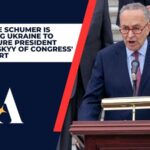Donald Trump will try to chip away at Joe Biden’s support among blue-collar voters when he meets with the Teamsters union Wednesday afternoon for a roundtable with their executive board and president.
Biden has already received several union endorsements, including an unexpectedly early one from the UAW.
Why It Matters
Union members across the country are voting more liberal than average and voting Democratic in contests between Republican candidates and Democratic ones, such as Michigan and Wisconsin. Union membership could prove decisive when elections take place.
On Tuesday, Unite Here labor union conducted an ambitious door-knocking operation urging its members to vote for Vice President Joseph Biden – including at least one visit by Biden himself to a Teamsters picket line in Belleville. Last week, UAW initiated new strikes targeting 38 GM and Stellantis sites across 20 states.
But Donald Trump is trying to undermine organized-labor support by asserting he will be more pro-union than his Democratic opponent, Sen. Bernie Sanders of Vermont. Trump also touts his promise of tariffs against China and reducing illegal immigration by building a wall along the border, both popular policies among Teamsters.
Unions Have a Big Role in Voting
Unions have long played a vital role in upholding workers’ rights through advocacy efforts to safeguard voting rights, linking workers’ rights with democracy. Their influence can be felt during election cycles and ballot measures that directly affect members.
Research by Sean McElwee at Data for Progress indicates that unionized workers tend to be more politically aware and participate in elections more actively than non-unionized workers, often voting more frequently as well.
Trump has been actively courting labor leaders as he vies for Teamster endorsement in key swing states such as Michigan and Wisconsin, in an attempt to cut into Joe Biden’s support from organized labor unions. Furthermore, Trump seeks to connect his policies to working people’s concerns, such as pledges to impose tariffs on Chinese goods or close down the U.S.-Mexico border – promises that economists warn could harm the economy. Furthermore, unions provide strong get-out-the-vote efforts in pivotal swing states – unions provide leadership when it comes to turnout efforts for vote campaigns in pivotal swing states.

Unions Are a Key Part of the Get-Out-the-Vote Efforts
Union members overwhelmingly favor Democratic candidates and policies, so their participation in political elections is crucial in driving turnout of its base (Ahlquist2017; Lamare2010; Leighley and Nagler2007). That is why organizations such as In Union attempt to counter right-wing echo chambers by providing newsletters outlining candidates’ policy positions as they would affect working people; also reaching out months in advance of elections and engaging nonmembers by hosting conversations about politics at voters’ doors educating them about each candidate.
Robert Putnam’s Bowling Alone emphasizes the significance of these activities for helping ordinary Americans to “punch above their weight” in American democracy, counterbalancing corporations and wealthy individuals’ disproportionate power through lobbying efforts and campaign contributions. Unions need to engage in these activities regularly if they wish to remain effective; otherwise many ordinary Americans could remain unaware of their roles within politics.
Union Endorsements Can Help
Studies of voter turnout continue to demonstrate the “union effect,” in that union members are more likely than non-member workers to vote even after controlling for other factors that might impact turnout. This phenomenon can be called the “union effect.”
Union membership is often motivated by occupational self-interest; however, its effectiveness can also be seen through how effectively organized they are and can mobilize members compared with other groups. Recent protests against Wisconsin Governor Scott Walker’s attempts to restrict collective bargaining rights demonstrate this point and illustrate that many public sector employees still feel strong motivation to vote in elections.
Evidence supporting these claims can be seen in data on local school board elections, which typically occur following summer primaries and are held each fall. As shown by Figure 4, teacher union endorsements are an incredibly predictive factor of candidate success over time and space even after taking into account factors like incumbency and electoral competitiveness.
- Friday Intraday Trading Sees Nvidia’s stock Market Cap Momentarily Cross $2 Trillion
- Trump’s January 6 Civil Cases Proceed While Criminal Case Is Halted
- Trump Delivers Speech at the Columbia Black Conservative Federation Gala
- Trump Declares Strong Support for IVF Following Alabama Supreme Court Decision
- Schumer in Ukraine Declares US Backing During House Aid Standoff






